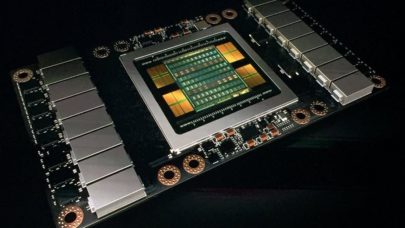
HPE Launches Apollo 6500 Gen10 System as Part of AI Solution Push
March 21, 2018
HPE today announced the latest rev of its HPE Apollo 6500 platform, Gen10, along with a spate of new AI-oriented offerings designed to help customers optimize a Read more…

Amazon Web Services Beats Cloud Rivals with First Volta Instances
October 26, 2017
Driven by a surging demand for HPC and AI compute power, the delay between the introduction of high-end GPUs and adoption by cloud vendors is shrinking. With th Read more…

PGI Rolls Out Support for Volta 100 in its 2017 Compilers and Tools Suite
September 14, 2017
PGI today announced a fairly lengthy list of new features to version 17.7 of its 2017 Compilers and Tools. The centerpiece of the additions is support for the T Read more…

First Volta-based Nvidia DGX Systems Ship to Boston-based Healthcare Providers
September 7, 2017
The Center for Clinical Data Science (CCDS), Boston, is at the confluence of major technology trends driving the healthcare industry: AI-based diagnostics of la Read more…

Nvidia Shares Recipe to Accelerate AI Cloud Adoption
May 29, 2017
In March, Nvidia revealed blueprints for a new open source Tesla GPU-based accelerator – HGX-1 – developed for clouds with Microsoft under its Project Olym Read more…

Nvidia’s Mammoth Volta GPU Aims High for AI, HPC
May 10, 2017
At Nvidia's GPU Technology Conference (GTC17) in San Jose, Calif., this morning, CEO Jensen Huang announced the company's much-anticipated Volta architecture a Read more…

Stacking Stairs Against the Memory Wall
April 2, 2013
With ever-mounting CPU advancements that promise superior performance, the blame for lousy delivery on those chip promises lies squarely on memory. This problem isn’t just a matter of application performance—it’s also a matter of efficiency. This week Micron with partners Intel and others, including Altera, IBM, ARM, Xilinx and others..... Read more…

Volta Adds Charge to GPU Roadmap
March 21, 2013
This week at NVIDIA's GPU Technology Conference, the priorities for GPU computing's future, including providing snappy access to high memory bandwidth, were cited as critical to growing user ranks. The energy consumption, data volume and velocity requirements are giving way to new, more efficient and higher bandwidth approaches, including Volta, which was revealed during the keynote event. Read more…

- Click Here for More Headlines

Whitepaper
Transforming Industrial and Automotive Manufacturing
In this era, expansion in digital infrastructure capacity is inevitable. Parallel to this, climate change consciousness is also rising, making sustainability a mandatory part of the organization’s functioning. As computing workloads such as AI and HPC continue to surge, so does the energy consumption, posing environmental woes. IT departments within organizations have a crucial role in combating this challenge. They can significantly drive sustainable practices by influencing newer technologies and process adoption that aid in mitigating the effects of climate change.
While buying more sustainable IT solutions is an option, partnering with IT solutions providers, such and Lenovo and Intel, who are committed to sustainability and aiding customers in executing sustainability strategies is likely to be more impactful.
Learn how Lenovo and Intel, through their partnership, are strongly positioned to address this need with their innovations driving energy efficiency and environmental stewardship.
Download Now
Sponsored by Lenovo
Whitepaper
How Direct Liquid Cooling Improves Data Center Energy Efficiency
Data centers are experiencing increasing power consumption, space constraints and cooling demands due to the unprecedented computing power required by today’s chips and servers. HVAC cooling systems consume approximately 40% of a data center’s electricity. These systems traditionally use air conditioning, air handling and fans to cool the data center facility and IT equipment, ultimately resulting in high energy consumption and high carbon emissions. Data centers are moving to direct liquid cooled (DLC) systems to improve cooling efficiency thus lowering their PUE, operating expenses (OPEX) and carbon footprint.
This paper describes how CoolIT Systems (CoolIT) meets the need for improved energy efficiency in data centers and includes case studies that show how CoolIT’s DLC solutions improve energy efficiency, increase rack density, lower OPEX, and enable sustainability programs. CoolIT is the global market and innovation leader in scalable DLC solutions for the world’s most demanding computing environments. CoolIT’s end-to-end solutions meet the rising demand in cooling and the rising demand for energy efficiency.
Download Now
Sponsored by CoolIT
Advanced Scale Career Development & Workforce Enhancement Center
Featured Advanced Scale Jobs:
HPCwire Resource Library
HPCwire Product Showcase
© 2024 HPCwire. All Rights Reserved. A Tabor Communications Publication
HPCwire is a registered trademark of Tabor Communications, Inc. Use of this site is governed by our Terms of Use and Privacy Policy.
Reproduction in whole or in part in any form or medium without express written permission of Tabor Communications, Inc. is prohibited.
























